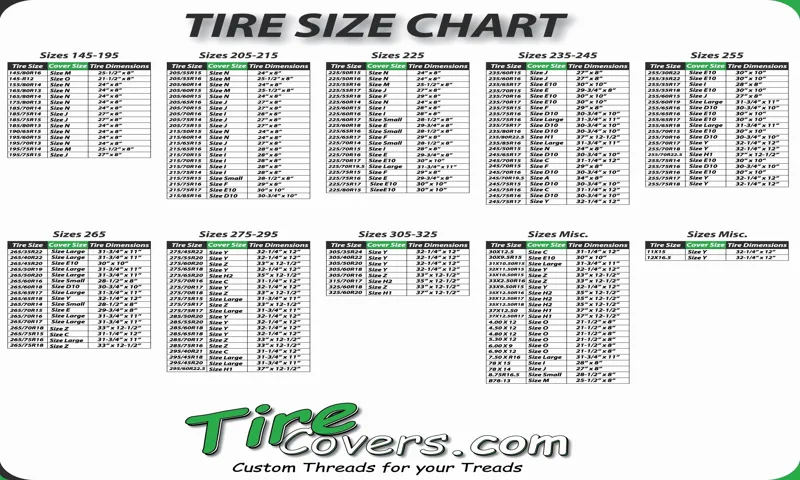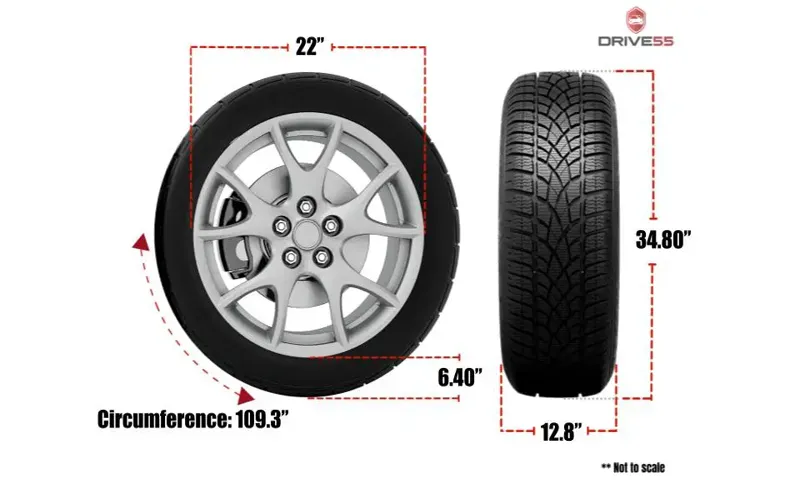Have you ever wondered what size a 325 tire is? Perhaps you’re shopping for new tires for your vehicle and are trying to figure out the appropriate size. Or maybe you’re just curious about the different tire sizes available. Whatever your reason, we’ve got you covered.
When it comes to tires, the numbers can be overwhelming and confusing. Luckily, understanding tire size is not as complicated as it may seem. The size of a tire is typically indicated on the sidewall, with a series of numbers and letters that provide information about the tire’s width, aspect ratio, and diameter.
A 325 tire is a type of tire that is 325 millimeters wide. The number following the width measurement indicates the tire’s aspect ratio, which is the height of the sidewall as a percentage of the tire’s width. For example, a 325/50 tire has a sidewall height that is 50% of the tire’s width.
It’s important to note that tire size can vary depending on the type of vehicle. A 325 tire may be appropriate for a certain type of truck or SUV, but not for a sedan or sports car. It’s always best to consult with a professional to determine the correct tire size for your specific vehicle.
In conclusion, the size of a 325 tire is 325 millimeters wide, with the number following the width indicating the aspect ratio. While understanding tire size may seem overwhelming at first, it’s an important factor to consider when shopping for new tires for your vehicle.
Understanding Tire Sizing
If you’re wondering what size a 325 tire is, it actually refers to the tire’s width in millimeters from one sidewall to the other. The second number in the tire size represents the aspect ratio or the height of the tire’s sidewall as a percentage of the width. For instance, a 325/40R20 tire means that the tire’s width is 325mm, and the sidewall’s height is 40% of the tire’s width.
Meanwhile, the letter R indicates that the tire has a radial construction, and the number 20 stands for the wheel’s diameter that the tire will fit into. It’s essential to select the correct sized tire to ensure that it fits properly on your vehicle, wears evenly, and performs optimally. You can usually find your vehicle’s recommended tire size in the owner’s manual or the driver’s side door jamb.
Don’t hesitate to ask a professional if you have any doubts or questions about the correct tire size for your car.
First Number: Width
When it comes to tire sizing, the first number you’ll often see refers to the width of the tire. This number is measured in millimeters and can usually be found on the sidewall of the tire. It’s important to get the right width for your vehicle, as it can affect a variety of factors including handling, fuel efficiency, and overall performance.
A tire that’s too narrow can create instability and reduce contact with the road, causing a loss of control on wet or uneven surfaces. On the other hand, a tire that’s too wide can increase drag and resistance, leading to lower fuel economy. To find the right width for your vehicle, consult your owner’s manual or talk to a professional at a tire shop.
By getting the right size and width, you can ensure that your tires perform optimally and keep you safe on the road.

Second Number: Aspect Ratio
When it comes to understanding tire sizing, it’s important to know what the second number on the tire represents – the aspect ratio. The aspect ratio is the percentage of the tire’s height compared to its width, and is denoted as a two-digit number after the slash in the tire size. For example, in a tire size of 225/45R17, the aspect ratio is 45, meaning that the height of the tire is 45% of its width.
This is important because it affects the tire’s performance and handling. A lower aspect ratio tire, such as a 30 or 35, will provide better handling and steering response, but will sacrifice some comfort and ride quality. On the other hand, a higher aspect ratio tire, such as a 60 or 70, will provide a softer ride and more comfort, but will sacrifice some handling and responsiveness.
It’s important to find the right balance between performance and comfort when selecting tires for your vehicle.
Third Number: Rim Diameter
When looking at the numbers on your tire, the third number you see refers to the rim diameter. This number indicates the size of the wheel that the tire fits onto. The rim diameter is measured from one end to the other and is typically displayed in inches.
It is crucial to purchase the correct tire size that matches your wheel size to ensure a safe and smooth ride. Using a tire with an incorrect rim diameter can cause the tire to not fit properly, leading to driving difficulties and even accidents. You can find the rim diameter size listed in your vehicle owner’s manual or on the inside of your car door panel.
If you are unsure about which tires to purchase, consult a professional mechanic or tire technician for assistance. Remember, getting the right tire size, including the rim diameter, is essential for a safe and enjoyable driving experience.
Interpreting a 325 Tire
If you’re wondering what size a 325 tire is, it’s actually quite simple. The number 325 refers to the tire’s width in millimeters, and is typically found on the tire’s sidewall. This measurement is useful for selecting the appropriate rim size, as well as determining whether or not a certain tire will fit your vehicle.
However, it’s important to note that there are other factors that come into play when selecting a tire, such as aspect ratio and load index. Consulting a tire professional or doing some research on your own can help ensure that you choose the right tire for your needs and vehicle. Overall, understanding tire measurements can help make the process of choosing new tires much easier and less confusing.
325 Width
When it comes to tires, the numbers on the sidewall can be pretty perplexing. One set of numbers you might come across is “32” This number refers to the tire’s section width, or the distance between the tire’s outermost points when it’s mounted on a rim and fully inflated.
Specifically, a 325 tire has a width of 325 millimeters, which is about 18 inches. This tells you how much of the tire’s surface area will come into contact with the road.
It’s important to note that section width isn’t the same as the tire’s tread width, which is the distance between the tire’s inner edges. Section width can vary depending on the tire’s aspect ratio, or the ratio of its sidewall height to its section width. So, when interpreting a 325 tire, it’s important to also take into consideration the other numbers on the sidewall to truly understand its size and dimensions.
Aspect Ratio
Aspect Ratio If you’ve ever looked at a tire size and felt confused by the numbers and letters on the sidewall, you’re not alone. One of the most important factors to understand is the tire’s aspect ratio. This number represents the ratio of the tire’s height to its width, typically expressed as a percentage.
For example, a 325 tire might have an aspect ratio of 50, meaning that the tire’s height is 50% of its width. This information can help you understand the tire’s shape and performance characteristics. A lower aspect ratio, such as 40 or below, usually means a wider, flatter tire that provides better handling and faster acceleration.
A higher aspect ratio, such as 60 or above, usually means a taller, more rounded tire that provides a smoother ride and better fuel economy. By understanding aspect ratio, you can choose the right tire for your vehicle and driving needs.
Rim Diameter
Have you ever wondered what the number 325 on a tire actually means? Well, it refers to the tire’s width in millimeters. However, interpreting the size of a tire goes beyond just the width. The rim diameter plays a crucial role as well.
The diameter is measured from one end of the wheel to the other and is also displayed in millimeters. So, if you have a 325 tire with a 20-inch diameter rim, that means the tire will fit a 20-inch wheel. It’s important to ensure that the tire’s diameter matches the rim for the best performance and safety on the road.
That’s why it’s recommended to consult your vehicle’s manual and a tire professional when choosing new tires. Understanding the tire size ensures that you’ll be driving with confidence and peace of mind.
Conclusion
In conclusion, asking what size a 325 tire is, is like asking how much wood a woodchuck could chuck. It all depends on the type and brand of the tire. However, one thing is for sure – it’s definitely not a one size fits all answer.
So, to avoid any confusion, it’s always best to check the manufacturer’s specifications before making any decisions. Happy driving!”
FAQs
What vehicles can use a 325 tire size?
A 325 tire size can be used on a variety of vehicles including SUVs, pickup trucks, and some passenger cars.
What is the width of a 325 tire?
The width of a 325 tire is approximately 325 millimeters.
What is the aspect ratio of a 325 tire size?
The aspect ratio of a 325 tire size is usually 35, which means the height of the tire is equal to 35% of its width.
Can I use a 325 tire on a vehicle with smaller or larger tires?
It is not recommended to use a tire size significantly smaller or larger than the recommended size for your vehicle. However, if it is only a slight difference, it can be used as long as it meets the load and speed rating requirements.
What is the load rating of a 325 tire size?
The load rating of a 325 tire size varies depending on the specific tire model, but is typically around 2500 pounds.
What is the speed rating of a 325 tire size?
The speed rating of a 325 tire size varies depending on the specific tire model, but is typically around 118 miles per hour.
Is a 325 tire size suitable for all types of weather?
The performance of a 325 tire size in different weather conditions will vary depending on the specific tire model. It is important to choose a tire with good traction and handling characteristics for the specific weather conditions in your area.

